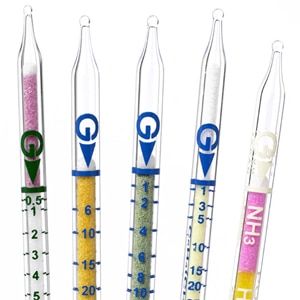
A detector tube is a graduated glass tube filled with a chemical reagent that will produce a color change, when exposed to the gas in question. It is used with a hand pump that will draw a sample into the tube.
The tubes are generally supplied in packages of ten, and are sealed at both ends. In operation, the tips are broken off, and the tube is inserted into the hand pump. Depending on the manufacturer, the pump utilizes either a bellows or piston design, drawing a 100 milliliter sample through the tube.
As the sample works its way up the tube toward the pump, it reacts with the reagent such that the length of the color change produced is proportional to concentration. The point where this reaction stops is read off against graduated markings on the tube.
Detector tubes are easy to use, are relatively inexpensive, and the method is intrinsically safe, allowing it to be deployed in all occupancies. [ISA-RP12.06.01 defines intrinsically safe equipment as “equipment and wiring which is incapable of releasing sufficient electrical or thermal energy under normal or abnormal conditions to cause ignition of a specific hazardous atmospheric mixture in its most easily ignited concentration.”]
Since detector tubes are available for hundreds of compounds, and have been around in a practical format since the 1930s, they are familiar to virtually anyone working in gas detection. But, ninety or so years after their introduction, there are now scores of gas detection instruments available. Thus, one might well ask when it is appropriate to use detector tubes.
We should first consider some of the disadvantages of detector tubes:
- Tubes are not very accurate. At best, expect ± 20%. More generally, expect ± 25%.
- Tubes can be quite temperature sensitive, and although correction data is customarily provided by the manufacturer, in practice it is not frequently applied. This is usually because the tube data sheet, supplied in the package, is not brought out into the field by the user. Out of sight, out of mind.
- While the detector tube catalogs tout availability for hundreds of compounds, there are far fewer unique reaction chemistries. As such, tubes are prone to interferences from other gases. To their credit, the manufacturers document these interferences—often far better than instrument manufacturers do. However, the information provided may not prove terribly helpful.
Even if you are told that compound “x” may interfere with the measurement of your target compound, you may have no idea if compound “x” is present, or at what concentration it may be present. Furthermore, a specific interference ratio is seldom given, and since the method is based on colorimetric reactions, certain compounds can bleach out the color change that should otherwise occur.
- Many tubes require that multiple pump strokes (creating multiples of the basic 100 mL sample size) be taken, to achieve the desired sensitivity. Errors can occur either from the failure to keep track of the number of strokes, from not allowing sufficient time for each sample to work its way through the tube before taking another pump stroke, or from “pre-cleanse” layers of the tube (intended to remove water vapor or other chemicals) being used up as they are taxed beyond their capacity.
- Owing to their basis in colorimetric reactions, the tubes have a shelf life, and many of them have to be stored at cold temperatures.
- Although so-called long-term detector tubes are available for a small number of compounds, the far more common standard tubes can only give the user a grab-sample “snapshot” of the air, and can never substitute for real-time monitoring.
For the most part, detector tubes are best used when a quick and dirty test will suffice. Examples would include:
- Testing around plumbing components where a leak is suspected, and it is known what compound would be leaking.
- Cursory evaluation of hazardous material spill situations, especially when more appropriate instruments are not available.
- Cursory evaluation of nuisance odor complaints, especially if there is a suspect compound.
Back in the day, the biggest advantage of tubes was that they were cheap. However, at upwards of $95.00 per package, and considering that inexpensive instruments are now available for many of the most common toxic compounds, this advantage is rapidly disappearing.
As suggested by the “quick and dirty” examples above, tubes have a place for one-shot evaluations, but are simply not appropriate for routine or prolonged use in the same location. After all, once a toxic gas problem has been identified, it must either be eliminated or continuously monitored.
A simple rule of thumb would be to question any routine or repeated use of detector tubes. There will almost always be a better way to fulfill the gas detection application.

